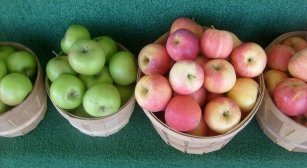| Back to Back Issues Page |
 |
|
Eat More Raw! March 31, 2014 |
March to Spring
I prefer to wait and until it warms up a bit more. So I get a pot of jasmine tea and shop through the seed catalog to select some of the produce I would like to plant in the garden. Every year we select a few plants that we have not had in the garden. This year we will grow in addition to our usual plants Rainbow Chard, dandelions, white tomatoes and collard greens. On this months radio program, The Fresh Cafe, my guests were the owners of Field To Fork farm. Scott and Jessica are passionate and well educated on farming local, organic produce. They have been involved in several farms and our community is so fortunate to have this local CSA that offers shares of produce at wholesale prices. If you do not have the time to grow your own garden or the space, look for a local CSA (Community Supported Agriculture farm) and support your local farmers. Today Robert and I went out to visit the local CSA farm for a compost workshop and to celebrate spring. We were so inspired to see the Field to Fork farm and meet people who love to garden. Learning ways to amend our soils to make them more nutrient dense helps put more nutrients into the foods we grow which is a bonus to growing some of your own food. Most homes produce the composting materials such as leaves, grass and kitchen materials so putting them all together in a balanced proportion makes for some rich amendments to enhance the soil. To learn more about composting click here
Scott, the CSA horticulturist said the three to one of brown to green, (carbon to nitrogen) is the rule of thumb in building a good compost. He also suggested adding in kelp meal to help give the compost a nice mineral boost. Great tip, we must find this kelp meal as it will also help put iodine into the soil which is often lacking in our area. There are many benefits to growing your own foods and buying locally grown produce. The produce is allowed to stay on the plant longer than most commercially grown produce. Most commercially grown produce is picked earlier to travel many miles, often put in distribution warehouses and then sent to the grocery stores. The production can add up to two weeks from being harvested to the arrive on the shelf at your grocery store. I hope you put on your wide brim hat, some gardening gloves and grab a spade and enjoy the gardening season to grow nutritious food for you and your friends and family. Rhonda
If you know of someone who may enjoy this newsletter, please forward this to them and suggest that they too sign up at: |
| Back to Back Issues Page |
